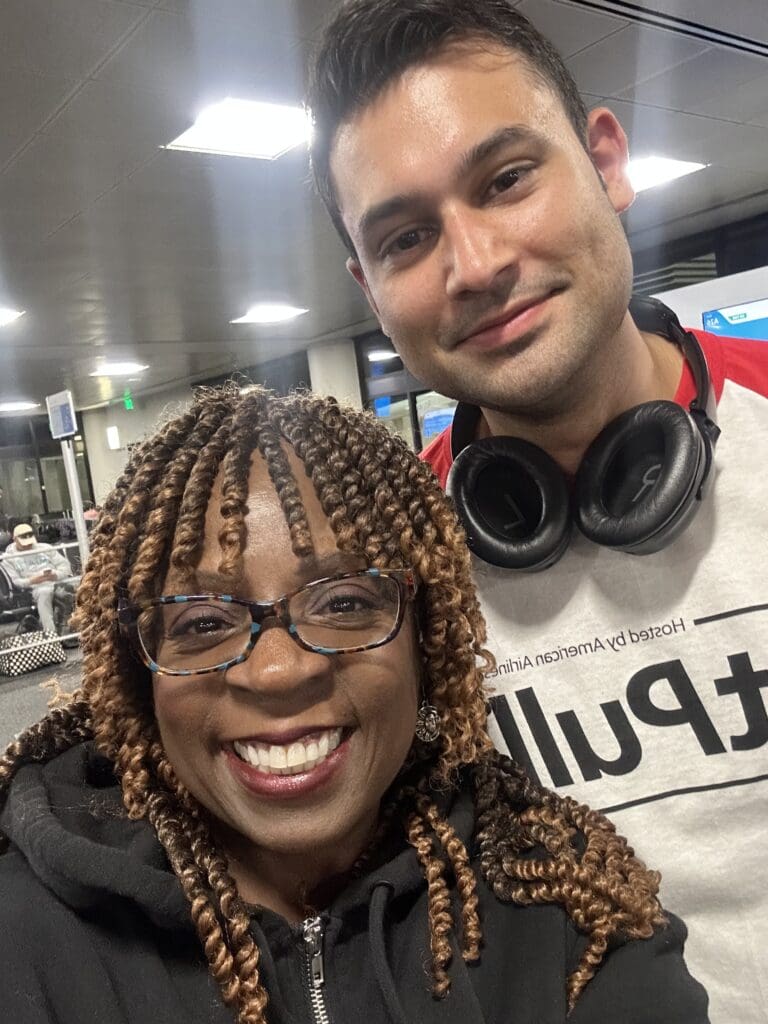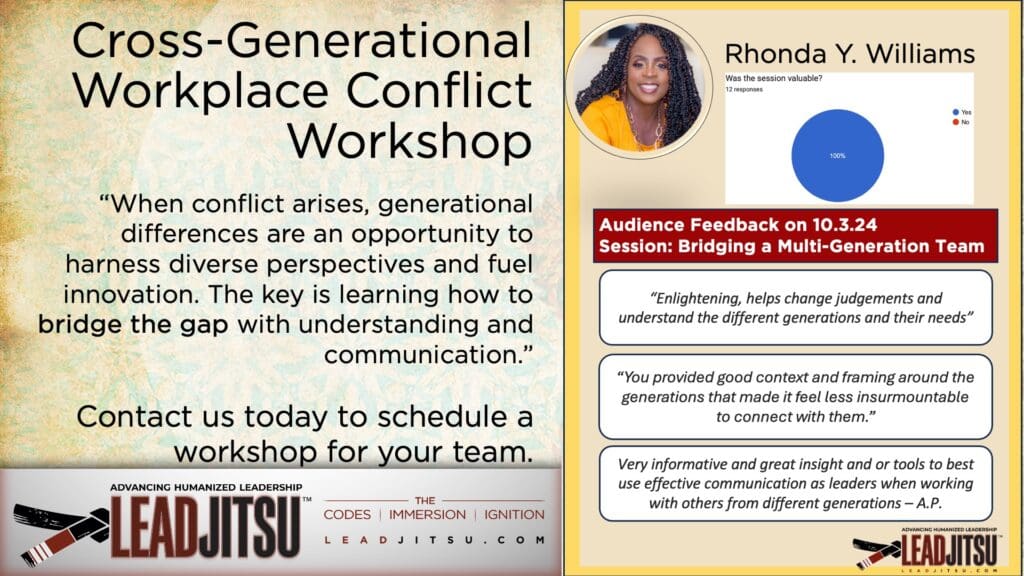Recently, as I boarded my flight home from Phoenix, I expected a routine journey, perhaps some time to reflect on recent work and prepare for the week ahead. But life has a way of teaching us lessons when we least expect it, and last night was no exception. Shortly after takeoff, a fellow passenger experienced a medical emergency. With the help of an onboard physician and EMT (Carlos pictured below)—and the critical assistance of an AED—they were able to stabilize him. The flight returned to Phoenix so he could receive proper care.
By the time we changed planes, navigated new paperwork, and finally took off, I made it home at 3:30 a.m.—weary, yet deeply reflective. The experience was a profound reminder of essential leadership principles: compassion, patience, self-regulation, respect, and a shared sense of responsibility. Here’s how these principles, at the heart of LEADJITSU, played out in real-time and offer us all insights into effective leadership.
Compassion: The Foundation of Leadership
In moments of crisis, compassion often becomes our first response. As soon as the passenger’s distress became evident, the sense of concern onboard was palpable. Passengers remained calm, allowing the medical professionals the space they needed to provide care. People offered their seats, adjusted their plans, and showed quiet understanding.
In leadership, compassion builds trust. When we approach others with genuine care, we create an environment where people feel valued. Compassion fosters empathy, enabling us to see beyond tasks and productivity to recognize the human side of our work. A compassionate leader builds strong relationships, showing that they genuinely care about the people they lead.
LEADJITSU Principle: This aligns with LEADJITSU’s “Empathetic Connection,” which teaches leaders the value of tuning into others’ needs. Compassion doesn’t mean avoiding hard decisions, but it does mean approaching each situation with a sense of humanity.

Patience: The Art of Accepting What We Cannot Control
Waiting to take off again after the emergency wasn’t easy. Changing planes and navigating delays tested everyone’s patience. But it was a valuable lesson in letting go of what we can’t control and focusing instead on what we can.
Leadership requires patience. Teams face delays, unexpected challenges, and setbacks. Leaders who demonstrate patience create a calming influence, setting an example that steadiness can help see us through uncertain times. Patience also enables leaders to make thoughtful decisions rather than reacting impulsively.
LEADJITSU Principle: This principle reflects “Kata Discipline” in LEADJITSU, which emphasizes consistency, control, and the ability to stay steady even in times of challenge. By practicing patience, leaders show their team that calm and considered responses lead to the best outcomes.
Self-Regulation: Mastering Emotions to Lead Effectively
During a stressful situation, it’s easy to let frustration or fear take over. Self-regulation became essential—not just for the medical professionals assisting the passenger but also for everyone around them. Controlling emotions and remaining composed allowed the plane’s crew and passengers to work as a team.
In leadership, self-regulation is crucial. Leaders who can control their emotions make better decisions and set a positive example for their team. Whether dealing with a crisis or a day-to-day challenge, a leader’s calm presence reassures those around them and fosters resilience within the team.
LEADJITSU Principle: This principle is central to “Mindful Self-Control” in LEADJITSU. Leaders with self-control can manage stress, remain solution-focused, and navigate difficult situations with composure, creating a sense of stability for their teams.
Enter the Generational Leadership Dojo
In today’s workforce, success isn’t just about managing teams—it’s about creating harmony across generations. The LEADJITSU Multi-Generational Leadership Workshop is a powerful, interactive experience designed to bridge the gap between Baby Boomers, Gen X, Millennials, and Gen Z. This 2.5-hour workshop equips leaders with the tools to foster respect, inclusion, and clear communication across generations.
Through practical exercises and the LEADJITSU Leader’s Code, your team will learn how to leverage generational diversity for innovation, collaboration, and sustained success. It’s time to move beyond generational divides and unite your team with a shared vision.
Empower your team to thrive together. Let’s build a future where every generation contributes to creating a dynamic and inclusive workplace.
Schedule a complimentary consultation today.
Respect: Honoring Each Person’s Contribution
Throughout the entire situation, respect was evident. The crew, medical professionals, and passengers all played their parts, respecting each other’s space, roles, and needs. This collaborative approach reminded me of the importance of respecting the contributions of others in any setting.
Respect is a core component of effective leadership. By honoring each team member’s strengths, skills, and perspectives, leaders build a culture of mutual appreciation and cooperation. Respectful leaders create an environment where everyone feels empowered to contribute, enhancing team cohesion and trust.
LEADJITSU Principle: “Dojo Respect” in LEADJITSU embodies this value, emphasizing the importance of treating every team member with reverence. Leaders who practice respect build teams that are united and motivated, knowing that their contributions matter.
Responsibility: Embracing Our Role in Collective Outcomes
Witnessing the collaborative effort to care for the passenger, return to Phoenix, and resume the journey was a reminder of shared responsibility. Each person, from the flight crew to the passengers, played a role in supporting the situation’s resolution.
Leadership is about more than individual performance; it’s about shared responsibility. Leaders recognize that every decision they make impacts others and that their role is to guide the collective toward positive outcomes. A sense of responsibility cultivates accountability and demonstrates a leader’s commitment to the well-being of their team.
LEADJITSU Principle: This principle ties into “Warrior’s Courage,” which underscores the bravery to step up, make difficult decisions, and uphold collective responsibility. Leaders who demonstrate this courage inspire their teams to face challenges head-on with unity and resolve.
Final Thoughts: LEADJITSU in Action
The in-flight emergency and subsequent journey home were unexpected lessons in leadership. They reinforced that true leadership is less about titles or authority and more about how we respond to life’s challenges, in the moment. By embodying compassion, patience, self-regulation, respect, and responsibility, leaders can inspire and guide their teams through both calm and turbulent times.
With LEADJITSU, we believe that these qualities are not just “nice-to-have” traits; they are the bedrock of successful, humanized leadership. Whether in moments of crisis or daily operations, these principles remind us that effective leadership is a choice—a choice to lead with heart, integrity, and a commitment to those around us.
As leaders, how can we create environments where compassion, patience, self-regulation, respect, and responsibility are practiced every day?
If you’re ready to explore how to integrate these principles into your leadership style, we invite you to enter the dojo and discover the transformative power of LEADJITSU.
Contact us to learn more.


